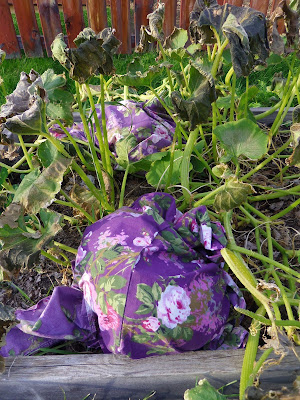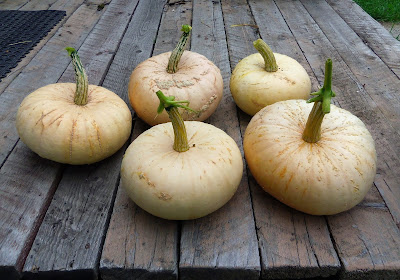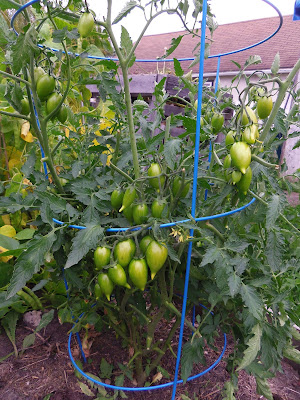The days are noticeably shorter and I have been sleeping more deeply at night. It feels strange to wake up early and find that it's still dark. I miss waking up to bright sunshine and birds singing at 5:00am. Time to transition into cozy mode.
We have had the furnace on in the mornings a few times to take the chill out of the air. Overall, though, it has been a mild September, with no killing frosts yet (as of September 24th - that's unsual) and none forecast for the next two weeks.
Flocks of Canada geese have been making their way overhead almost daily. There have been some large groups - you can hear them coming long before you spot them.
I gradually started bringing in the dry bush bean plants to hang in the second week of September. Most are inside now, except for a Ruckle bean plant.
On the 15th (a very cool, cloudy, damp day), I picked most the tomatoes that were in the East garden and in containers along the driveway because the first frost was forecast for that night. Harvested on - or just before - the 15th were Jewish, Candy Sweet Icicle, Black Krim, Wentzell, Emerald Evergreen, and Black Sea Man. I left the tomatoes growing along the south side of the house in-ground and covered them that night. I also pulled the remainder of the Gaspe Flint corn and a few of the Agate Pinto bean pods to bring inside to dry in case the frost zapped those plants. Most of the Agate Pinto beans on the plants are still green and not ready to harvest.
(Click on pictures to enlarge.)
On the morning of the 16, there were signs outside of a light frost. The only things that got zapped were the winter squash (Galeux D'Eysines) plants. Arhg. Some of those squash weren't fully mature yet, so I left them on the vines for a few more days.
There are little boxes, plates, and long, flat cardboard trays of bean pods, nasturtium seeds, tomato seeds, and garlic bulbils set all around the plant room and living room to dry. Several buckets of green tomatoes are in the laundry room, waiting to be boxed up in newspaper so they can ripen.
Tene's beans (dry/bush)
Beka Brown (dry/bush)
Agate pinto beans (dry bush w/runners)
Nasturtium seeds
The Red Swan and Calima beans that grew were picked late in the season and are drying down indoors. These varieties were not eaten fresh or processed for freezing this year (small plants, lots of slug damage); I am saving seed from them instead.
The Early Prolific Summer Squash plants produced 3 or 4 small squash, so I guess it's more accurate to say that they underperformed rather than counting them as a crop failure.
The Long Pie Pumpkin, Lower Salmon River squash, and Cole tomatoes that were planted at R's family's farm were all either killed by frost damage early in the season or inhibited by the cool, wet weather this summer. None of pumpkins produced and we only got 4 small Cole tomatoes (a variety that typically produces very well). One average-size and one tiny Lower Salmon River were harvested (both pictured below).
Most of the carrots and 4 little cabbages are still in the raised beds. They can withstand light frosts, so should be fine outside for a while longer.
September 17th was a carrot processing day. It's easy to forget how much time it consumes to pull, wash, peel, chop, blanch, and then dehydrate them. Hours. Thank goodness for podcasts. By the time I'm through processing the second batch of carrots, I am wondering what the hell I was thinking planting them in the first place. Mid-winter, though, when you can just open a jar and add dehydrated carrots to a soup or stew, I'm glad I put in the effort.
September 18 & 19 - I picked the Bellestar and half the Principe Borghese tomatoes. The Galeux D'Eysines squash were harvested as well as a few of the Work Release Paste tomatoes that were best for seed saving. I processed another batch of carrots. The air was hazy these two days and smelled like a giant campfire. Smoke from the massive wildfires throughout the US west coast had reached northern BC.
September 23 - Picked the remainder of the Principe Borghese tomatoes. Pulled the Agate pinto beans and hung the plants to dry.
September 24 - Picked the Hungarian Heart tomatoes.
Setpember 26 - Picked the Striped German and Work Release Paste tomatoes.
The only things remaining in the garden are the sunflowers, cosmos, lemon balm, mint, sage, a bit of kale, carrots, a single Ruckle bean plant (the pods are being stubborn and are remaining green), 3 cabbage, and a few volunteer pansies.
The crop failures this year were the peas (Green Arrow and Laxton's Progress), cauliflower, White Scallop summer squash, Table King Acorn squash, Romano beans, Anaheim peppers, and Norland potatoes.
There are several jars of fermenting tomato seeds on the go. Black Sea Man, Cream Sausage, and Jewish (left to right) are pictured in the jars below. The problem with using the cat tree as the platform for pictures (the best light is in the plant room) is that curious kitties are irresistibly drawn to things that are fragile or carefully arranged. Case in point...








































